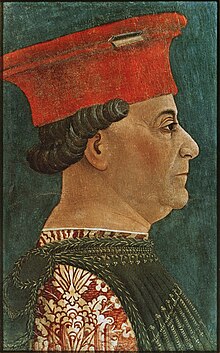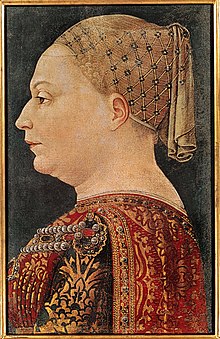Francesco I SforzaKG(Italian:[franˈtʃeskoˈpriːmoˈsfɔrtsa];23 July 1401 – 8 March 1466) was an Italiancondottierowho founded theSforzadynasty in theduchy of Milan,ruling as its (fourth)dukefrom 1450 until his death.
| Francesco I Sforza | |
|---|---|
 Portrait of Francesco Sforza (c. 1460) byBonifacio Bembo.Sforza insisted on being shown in his worn dirty old campaigning hat.Pinacoteca di Brera,Milan. | |
| Duke of Milan | |
| Reign | 25 March 1450 – 8 March 1466 |
| Predecessor | Golden Ambrosian Republic |
| Successor | Galeazzo Maria Sforza |
| Born | 23 July 1401 Cigoli, San Miniato,Republic of Florence |
| Died | 8 March 1466(aged 64) Milan,Duchy of Milan |
| Spouse | Polissena Ruffo Bianca Maria Visconti |
| Issue | Galeazzo Maria Sforza,Duke of Milan Ippolita Maria Sforza,Duchess of Calabria Filippo Maria Sforza, Count of Corsica Sforza Maria Sforza, Duke of Bari Francesco Galeazzo Maria Sforza Ludovico Sforza,Duke of Milan Ascanio Maria Sforza Elisabetta Maria Sforza, Marquise of Montferrato Ottaviano Maria Sforza, Count of Lugano |
| House | Sforza |
| Father | Muzio Attendolo Sforza |
| Mother | Lucia de Martini (Demartini) |


In the 1420s, he participated in theWar of L'Aquilaand in the 1430s fought for thePapal Statesand Milan againstVenice.Once the war between Milan and Venice ended in 1441 undermediationby Sforza, he successfully invaded southern Italy alongsideRené of Anjou,pretender to the throne of Naples, and after that returned toMilan.He was instrumental in theTreaty of Lodi(1454) which ensured peace in the Italian realms for a time by ensuring a strategic balance of power. He died in 1466 and was succeeded as duke by his son,Galeazzo Maria Sforza.While Sforza was recognized as duke of Milan, his sonLudovicowould be the first to have formal investiture under theHoly Roman EmpirebyMaximilian Iin 1494.
Biography
editEarly life
editFrancesco Sforza was born inCigoli,nearSan Miniato,Tuscany, one of the seven illegitimate sons of thecondottieroMuzio Sforza[1]andLucia de Martini.[2]He was the brother ofAlessandro Sforza.He spent his childhood inTricarico(in the modernBasilicata), the marquisate of which he was granted in 1412 byKing Ladislaus of Naples.In 1418, he marriedPolissena Ruffo,a Calabrese noblewoman.[3]
From 1419, he fought alongside his father, soon gaining fame for being able to bend metal bars with his bare hands. He later proved himself to be an expert tactician and a very skilled field commander. After the death of his father during theWar of L'Aquila,he participated inBraccio da Montone's final defeat in that campaign; he fought subsequently for the Neapolitan army and then forPope Martin Vand theDuke of Milan,Filippo Maria Visconti.After some successes, he fell in disgrace and was sent to the castle ofMortaraas a prisoner. He regained his status after leading an expedition againstLucca.
In 1431, after fighting again for thePapal States,he led the Milanese army againstVenice;the following year the duke's daughter,Bianca Maria,was betrothed to him.[1]Despite these moves, the wary Filippo Maria never ceased to be distrustful of Sforza. The allegiance of mercenary leaders was dependent, of course, on pay; in 1433–1435, Sforza led the Milanese attack on the Papal States, but when he conqueredAncona,inMarche,he changed sides, obtaining the title of vicar of the city directly fromPope Eugene IV.[4]In 1436–39, he served variously both inFlorenceand Venice.
In 1440, his fiefs in theKingdom of Napleswere occupied byKing Alfonso I,and, to recover the situation, Sforza reconciled himself with Filippo Visconti. On 25 October 1441, inCremona,he could finally marry Bianca Maria as part of theagreementsthat ended the war between Milan and Venice. The following year, he allied withRené of Anjou,pretender to the throne of Naples, and marched against southern Italy. After some initial setbacks, he defeated the Neapolitan commander Niccolò Piccinino, who had invaded his possessions in Romagna and Marche, through the help ofSigismondo Pandolfo Malatesta(who had married his daughterPolissena) and the Venetians, and could return to Milan.
Sforza later found himself warring againstFrancesco Piccinino(whom he defeated at theBattle of Montolmoin 1444) and, later, the alliance of Visconti, Eugene IV, and Malatesta, who had allegedly murdered Polissena. With the help of Venice, Sforza was again victorious and, in exchange for abandoning the Venetians, received the title ofcapitano generale(commander-in-chief) of the Duchy of Milan's armies.
Duke of Milan
editAfter Filippo Maria Visconti, duke of Milan, died without a male heir in 1447, fighting broke out to restore the so-calledAmbrosian Republic.[5]The name Ambrosian Republic takes its name fromSt. Ambrose,thepatron saintof Milan.[5]Agnese del Maino,his wife's mother, convinced the condottiero who heldPaviato restore it to him.[6]
He also received the seigniory of other cities of the duchy, includingLodi,and started to carefully plan the conquest of the ephemeral republic, allying withWilliam VIII of Montferratand (again) Venice. In 1450, after years of famine, riots raged in the streets of Milan and the city's senate decided to entrust him with the duchy. Sforza entered the city as duke on 26 February. It was the first time that such a title was handed over by a lay institution. While the other Italian states gradually recognized Sforza as the legitimate Duke of Milan, he was never able to obtain official investiture from theHoly Roman Emperor.That did not come to the Sforza Dukes until 1494, whenEmperor Maximilianformally invested Francesco's son,Ludovico,as duke of Milan.
Under his rule (which was moderate and skilful), Sforza modernised the city and duchy. He created an efficient system of taxation that generated enormous revenues for the government, his court became a centre ofRenaissancelearning and culture, and the people of Milan grew to love him. In Milan, he founded theOspedale Maggiore,restored thePalazzo ducale,and had theNaviglio d'Adda,a channel connecting with theRiver Adda,built.
During Sforza's reign, Florence was under the command ofCosimo de' Mediciand the two rulers became close friends. This friendship eventually manifested in first thePeace of Lodiand then theItalian League,a multi-polar defensive alliance of Italian states that succeeded in stabilising almost all of Italy for its duration. After the peace, Sforza renounced part of the conquests in eastern Lombardy obtained by his condottieriBartolomeo Colleoni,Ludovico Gonzaga,andRoberto Sanseverino d'Aragonaafter 1451. AsKing Alfonso I of Napleswas among the signatories of the treaty, Sforza also abandoned his long support of theAngevinpretenders to Naples. He also aimed to conquerGenoa,then an Angevin possession; when a revolt broke out there in 1461, he hadSpinetta Campofregosoelected asDoge,as his puppet. Sforza occupied Genoa andSavonain 1464.
Sforza was the first European ruler to follow a foreign policy based on the concept of thebalance of power,and the first native Italian ruler to conduct extensive diplomacy outside the peninsula to counter the power of threatening states such as France. Sforza's policies succeeded in keeping foreign powers from dominating Italian politics for the rest of the century.
Edward IV of Englandsought to strengthen friendly relations with Sforza and accordingly offered him membership in the prestigiousOrder of the Garter.[7]He accepted and became a knight of the Garter in 1463.[8]
Sforza suffered fromhydropsyandgout.In 1462, rumours spread that he was dead and a riot exploded in Milan. He however survived for four more years, finally dying in March 1466. He was succeeded as duke by his son,Galeazzo Maria Sforza.
Francesco's successor Ludovico commissionedLeonardo da Vincito design anequestrian statueas part of a monument to Francesco I Sforza. A clay model of a horse which was to be used as part of the design was completed by Leonardo in 1492—but the statue was never built. In 1999 the horse alone was cast from Leonardo's original designs in bronze and placed in Milan outside the racetrack of Ippodromo del Galoppo.
Issue
editFrancesco Sforza with his second wife Bianca Maria Visconti had:
- Galeazzo Maria(24 January 1444 — 26 December 1476), Duke of Milan from 1466 to 1476.[9]
- Ippolita Maria(18 April 1446 — 20 August 1484), wife ofAlfonso II of Naplesand mother ofIsabella of Aragon,[10]who was to marry Galeazzo's heir.
- Filippo Maria (12 December 1449 — 1492), Count of Corsica. Married to his cousin Costanza Sforza.[11]
- Sforza Maria(18 August 1451 — 29 July 1479), Duke of Bari from 1464 to 1479. Betrothed (possibly married) toEleanor of Naples
- Francesco Galeazzo Maria (5 August 1453/54 — died young).
- Ludovico Maria(3 August 1452 — 27 May 1508), Duke of Bari from 1479 to 1494 and Duke of Milan from 1494 to 1499.
- Ascanio Maria(3 March 1455 — 28 May 1505), Abbot of Chiaraville, Bishop of Pavia, Cremona, Pesaro, and Novara and Cardinal.
- Elisabetta Maria (10 June 1456 — 1473), wife ofGuglielmo VIII Paleologo,Margrave of Montferrat.
- Ottaviano Maria (30 April 1458 — 1477), Count of Lugano, who drowned while escaping arrest.
- Carlo
- female child
Francesco Sforza also had an unspecified number (possibly 35) of illegitimate children.
Giovanna d'Acquapendente,who was Francesco's official lover between the death of his first wife and his marriage to Bianca Maria Visconti, gave him 7 children including:
- Polissena (b. 1422) Died young
- Isolea or Isotta (b.1427- d. 1485/87) marriedAndreo Matteo Acquavivaand after his death Giovanni Mauruzi[12]
- Polisena Sforza(1428 – June 1, 1449) marriedSigismondo Pandolfo Malatesta
- Sforza Secondo Sforza(1433–1492 or 1493),count of Borgonuovo;married Antonia dal Verme daughter ofLuigi dal Verme.
- Drusiana Sforza(30 September 1437 - 29 June 1474), marriedJacopo Piccinino.[12]
with Brigida Caimi (daughter of Franchino Caimi)
- Giovanni Maria(Milan, 1461 - Pavia, 1510 or 1513), archbishop of Genoa from 1498
with Elisabetta de Prata
- Giulio married Margherita Grassi, daughter of Tommaso Grassi, Patrizio di Milano
with Perpetua di Varese[13]
- Polidoro[14](b.1442 -d. 1475) married Antonia Malaspina,illegitemate daughter of Spinetta of Verrucola,
with Elisabetta da Robecco( also known as Elisabetta delle Grazie)
- Leonardo
- Julius
By unknown mothers
- Tristano Sforza (1424-1477) married Beatrice d´Este, an illegitimate daughter ofNiccolò III d'Este,marquess of Ferrarra
- Bona Francesca (d. 1513)
- Bianca Maria
- Fiordelisa Maria married Guidaccio Manfredi.
- Bartolomeo
- Antonio
- Paolo (b.1454)
- Lucia[15](b.?-d.?became a nun
- Taddea[15](b.?-d.?became a nun
- Clara[15](b.?-d.?) became a nun
- Elisa
- Griselda (b.1452-1495)
- Beatrice (b.1455-1493)
- Ottaviana (b.1461-1513)
References
edit- ^abWilliams 1998,p. 201.
- ^Walsh 2005,p. 395.
- ^Fletcher 2013,p. 79.
- ^Gregorovius 1967,p. 42.
- ^abLucas 1960,p. 268.
- ^Echols & Williams 1992,p. 21-22.
- ^Ross 1997,p. 274.
- ^Vale 2022,p. 9.
- ^Bartlett 2019,p. 125.
- ^Fallows 2010,p. 39.
- ^Lubkin, Gregory (1 September 2023).A Renaissance Court: Milan under Galleazzo Maria Sforza.University of California Press.ISBN978-0-520-91345-5.
- ^abBartlett, Kenneth R. (17 July 2013).A Short History of the Italian Renaissance.University of Toronto Press.ISBN978-1-4426-0877-1.
- ^II, Pope Pius (November 2013).Europe (c. 1400-1458).CUA Press.ISBN978-0-8132-2182-3.
- ^Bartlett, Kenneth R. (17 July 2013).A Short History of the Italian Renaissance.University of Toronto Press.ISBN978-1-4426-0877-1.
- ^abcSantoro, Caterina (1 January 1999).Gli Sforza: La casata nobiliare che resse il Ducato di Milano dal 1450 al 1535(in Italian). Lampi di stampa.ISBN978-88-488-0056-3.
Sources
edit- Bartlett, Kenneth (2019).The Renaissance in Italy: A History.Hackett Publishing Company, Inc.
- Echols, Anne; Williams, Marty (1992).An annotated index of medieval women.Markus Wiener Publishing, Inc.
- Fallows, Noel (2010).Jousting in Medieval and Renaissance Iberia.The Boydell Press.
- Fletcher, Stella (2013).The Longman Companion to Renaissance Europe, 1390-1530.Routledge.
- Gregorovius, Ferdinand (1967).History of the City of Rome in the Middle Ages.Vol. 7. AMS Press.
- Ippolito, Antonio Menniti (1998)."Francesco I Sforza, duca di Milano".Dizionario Biografico degli Italiani.Vol. 50. Treccani.
- Lucas, Henry S. (1960).The Renaissance and the Reformation.Harper Bros.: New York.
- Rendina, Claudio (1994).I capitani di ventura.Rome: Netwon Compton.
- Robin, Diana, ed. (2009).Francesco Filelfo: Odes.Harvard University Press.
- Ross, Charles (1997).Edward IV.Yale University Press.ISBN978-0-30007-371-3.
- Walsh, Richard J. (2005).Charles the Bold and Italy (1467-1477): Politics and Personnel.Liverpool University Press.
- Vale, Malcolm (2022)."England and Europe: England and Europe c.1450 - 1520: Nostalagia or New Opportunities?".In Clark, Linda (ed.).The Fifteenth Century XIX: Enmity and Amity.The Boydell Press.ISBN978-1-78327-742-1.
- Williams, George L. (1998).Papal Genealogy: The Families and Descendants of the Popes.McFarland & Company, Inc.